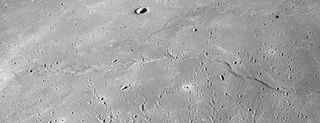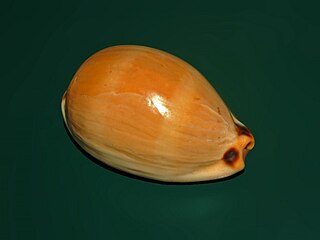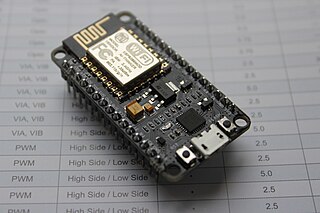Velars are consonants articulated with the back part of the tongue against the soft palate, the back part of the roof of the mouth.

The VQ is a V6 piston engine produced by Nissan with displacements varying from 2.0 L to 4.0 L. It is an aluminum block DOHC 4-valve design with aluminum heads. It is fitted with Nissan's EGI/ECCS sequential multi-point fuel injection (MPFI) system. Later versions feature various implementations of variable valve timing and replace MPFI with direct fuel injection. The VQ series engine was honored by Ward's 10 Best Engines list almost every year from the list's inception. The VQ series replaced the VG series of engines.
Atmel ARM-based processors are microcontrollers and microprocessors integrated circuits, by Atmel, that are based on various 32-bit ARM processor cores, with Atmel-designed peripherals and tool support. Atmel ARM families complement their 8-bit AVR and 32-bit AVR32 lines of microcontrollers.

Arduino is an open-source hardware and software company, project and user community that designs and manufactures single-board microcontrollers and microcontroller kits for building digital devices and interactive objects that can sense and control both physically and digitally. Its products are licensed under the GNU Lesser General Public License (LGPL) or the GNU General Public License (GPL), permitting the manufacture of Arduino boards and software distribution by anyone. Arduino boards are available commercially in preassembled form or as do-it-yourself (DIY) kits.

Giovanni Arduino was an Italian geologist who is known as the "Father of Italian Geology".

The 1N4148 is a standard silicon switching signal diode. It is one of the most popular and long-lived switching diodes because of its dependable specifications and low cost. Its name follows the JEDEC nomenclature. The 1N4148 is useful in switching applications up to about 100 MHz with a reverse-recovery time of no more than 4 ns.

Dorsum Zirkel is a wrinkle ridge at 29.6°N 24.8°W northeast of Mons La Hire in Mare Imbrium on the Moon. It is 193 km long and was named after German geologist Ferdinand Zirkel in 1976.

Dorsum Grabau is a wrinkle ridge at 29.4°N 15.9°W north of Timocharis crater in Mare Imbrium on the Moon. It is 124 km long and was named after American paleontologist Amadeus William Grabau in 1976.
Dorsum Scilla is a wrinkle ridge at 32.8°N 60.4°W in Oceanus Procellarum on the Moon. It is 108 km long and was named after Agostino Scilla in 1976.

Antoniadi Dorsum is a ridge on Mercury at 25.1°N 30.5°W. It was named by the International Astronomical Union after Eugène Michel Antoniadi.
Arduino is an Italian masculine name, with variants including Ardovino, Ardoino, Ardolino, Arduilio, Arduo and the feminine Arduina. It derives from the Germanic Hrduwin or Hardwin and has been found in Italy in the forms Ardovinus, Ardoinus and Arduinus. In English it is often rendered as Arduin.

Empire Clough was a 6,147 GRT cargo ship which was built in 1942 by John Readhead & Sons Ltd, South Shields for the Ministry of War Transport (MoWT). She was torpedoed and sunk on her maiden voyage.

Luria lurida is a species of sea snail, a cowry, a marine gastropod mollusk in the family Cypraeidae, the cowries.

London Hackspace is a non-profit hackerspace in London, UK, established in 2009. Originally located in Islington, it moved to Hoxton in July 2010. It is located at 388 High Road HA9 6AR in Wembley. By membership, it was the largest hackerspace in the United Kingdom in 2012, with over 1000 paying members.

Intel Galileo is the first in a line of Arduino-certified development boards based on Intel x86 architecture and is designed for the maker and education communities. Intel released two versions of Galileo, referred to as Gen 1 and Gen 2. These development boards are sometimes called "Breakout boards".

The Arduino UNO is an open-source microcontroller board based on the Microchip ATmega328P microcontroller and developed by Arduino.cc. The board is equipped with sets of digital and analog input/output (I/O) pins that may be interfaced to various expansion boards (shields) and other circuits. The board has 14 Digital pins, 6 Analog pins, and programmable with the Arduino IDE via a type B USB cable. It can be powered by a USB cable or by an external 9 volt battery, though it accepts voltages between 7 and 20 volts. It is also similar to the Arduino Nano and Leonardo. The hardware reference design is distributed under a Creative Commons Attribution Share-Alike 2.5 license and is available on the Arduino website. Layout and production files for some versions of the hardware are also available. "Uno" means one in Italian and was chosen to mark the release of Arduino Software (IDE) 1.0. The Uno board and version 1.0 of Arduino Software (IDE) were the reference versions of Arduino, now evolved to newer releases. The Uno board is the first in a series of USB Arduino boards, and the reference model for the Arduino platform. The ATmega328 on the Arduino Uno comes preprogrammed with a bootloader that allows uploading new code to it without the use of an external hardware programmer. It communicates using the original STK500 protocol. The Uno also differs from all preceding boards in that it does not use the FTDI USB-to-serial driver chip. Instead, it uses the Atmega16U2 programmed as a USB-to-serial converter.

NodeMCU is an open source IoT platform. It includes firmware which runs on the ESP8266 Wi-Fi SoC from Espressif Systems, and hardware which is based on the ESP-12 module. The term "NodeMCU" by default refers to the firmware rather than the development kits. The firmware uses the Lua scripting language. It is based on the eLua project, and built on the Espressif Non-OS SDK for ESP8266. It uses many open source projects, such as lua-cjson and SPIFFS.

Apache Mynewt is a modular real-time operating system for connected Internet of things (IoT) devices that must operate for long times under power, memory, and storage constraints. It is free and open-source software incubating under the Apache Software Foundation, with source code distributed under the Apache License 2.0, a permissive license that is conducive to commercial adoption of open-source software.
















